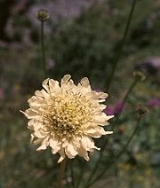
Cephalaria
Encyclopedia
Cephalaria is a genus of about 65 species of flowering plant
s in the family Dipsacaceae
, native to southern Europe
, western and central Asia
, and northern and southern Africa
.
They are annual
or perennial
herbaceous
plants growing to 0.8-2 m tall.
Cephalaria species are used as food plants by the larva
e of some Lepidoptera
species including Schinia imperialis
, which feeds exclusively on C. procera.
Selected species:
s in gardens; the most popular species is C. gigantea, a perennial species from the Caucasus
growing to 2 m tall, valued for its strong erect growth with dark green foliage and yellow flowers (Huxley 1992).
Flowering plant
The flowering plants , also known as Angiospermae or Magnoliophyta, are the most diverse group of land plants. Angiosperms are seed-producing plants like the gymnosperms and can be distinguished from the gymnosperms by a series of synapomorphies...
s in the family Dipsacaceae
Dipsacaceae
The Dipsacaceae, or teasel family, of the order Dipsacales contains 350 species of perennial or biennial herbs and shrubs in eleven genera. Native to most temperate climates, they are found in Europe, Asia and Africa...
, native to southern Europe
Europe
Europe is, by convention, one of the world's seven continents. Comprising the westernmost peninsula of Eurasia, Europe is generally 'divided' from Asia to its east by the watershed divides of the Ural and Caucasus Mountains, the Ural River, the Caspian and Black Seas, and the waterways connecting...
, western and central Asia
Asia
Asia is the world's largest and most populous continent, located primarily in the eastern and northern hemispheres. It covers 8.7% of the Earth's total surface area and with approximately 3.879 billion people, it hosts 60% of the world's current human population...
, and northern and southern Africa
Africa
Africa is the world's second largest and second most populous continent, after Asia. At about 30.2 million km² including adjacent islands, it covers 6% of the Earth's total surface area and 20.4% of the total land area...
.
They are annual
Annual plant
An annual plant is a plant that usually germinates, flowers, and dies in a year or season. True annuals will only live longer than a year if they are prevented from setting seed...
or perennial
Perennial plant
A perennial plant or simply perennial is a plant that lives for more than two years. The term is often used to differentiate a plant from shorter lived annuals and biennials. The term is sometimes misused by commercial gardeners or horticulturalists to describe only herbaceous perennials...
herbaceous
Herbaceous
A herbaceous plant is a plant that has leaves and stems that die down at the end of the growing season to the soil level. They have no persistent woody stem above ground...
plants growing to 0.8-2 m tall.
Cephalaria species are used as food plants by the larva
Larva
A larva is a distinct juvenile form many animals undergo before metamorphosis into adults. Animals with indirect development such as insects, amphibians, or cnidarians typically have a larval phase of their life cycle...
e of some Lepidoptera
Lepidoptera
Lepidoptera is a large order of insects that includes moths and butterflies . It is one of the most widespread and widely recognizable insect orders in the world, encompassing moths and the three superfamilies of butterflies, skipper butterflies, and moth-butterflies...
species including Schinia imperialis
Schinia
Schinia, commonly called Flower Moths, is a large genus of moths belonging to the family Noctuidae. The genus has a Holarctic distribution with the vast majority of species being found in North America, many with a very restricted range and larval food plant.-Species Information and Food Plants:...
, which feeds exclusively on C. procera.
Selected species:
- Cephalaria alpina (L.) Roem. & Schult.
- Cephalaria ambrosioides (Sibth. & Sm.) Roem. & Schult.
- Cephalaria aristata C.Koch
- Cephalaria coriacea (Willd.) Roem. & Schult. ex Steud.
- Cephalaria flava (Sibth. & Sm.) Szabó
- Cephalaria gigantea (Ledeb.) Bobrov – Tatarian Cephalaria
- Cephalaria joppica (Spreng.) Bég.
- Cephalaria laevigata (Waldst. & Kit.) Schrad.
- Cephalaria leucantha (L.) Roem. & Schult.
- Cephalaria linearifolia Lange
- Cephalaria litvinovii Bobrov
- Cephalaria pastricensis Dörfl. & Hayek
- Cephalaria radiata Griseb. & Schenk
- Cephalaria setulifera Boiss. & Heldr.
- Cephalaria squamiflora (Sieber) Greuter
- Cephalaria scabra (L.f.) Roem. & Schult.
- Cephalaria syriaca (L.) Roem. & Schult. – Syrian Cephalaria
- Cephalaria tchihatchewii Boiss.
- Cephalaria transylvanica (L.) Roem. & Schult.
- Cephalaria uralensis (Murray) Roem. & Schult.
Cultivation and uses
Some species are grown as ornamental plantOrnamental plant
Ornamental plants are plants that are grown for decorative purposes in gardens and landscape design projects, as house plants, for cut flowers and specimen display...
s in gardens; the most popular species is C. gigantea, a perennial species from the Caucasus
Caucasus
The Caucasus, also Caucas or Caucasia , is a geopolitical region at the border of Europe and Asia, and situated between the Black and the Caspian sea...
growing to 2 m tall, valued for its strong erect growth with dark green foliage and yellow flowers (Huxley 1992).

